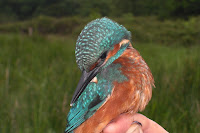 ngfisher and new grasshopper warbler.
ngfisher and new grasshopper warbler.We caught a total of 30 birds (15 species), including 2 whitethroat, 1 female blackcap and 2 chiffchaff, one of which was a retrap from couple of years ago.
Tony, Ipsley Alders

 ngfisher and new grasshopper warbler.
ngfisher and new grasshopper warbler.
 To thank our local volunteers for their hard work over the winter and at the Open Day, S.E. Worcs. group organised a "thankyou" event at Tiddesley Wood. A walk through the wood led by Harry Green was followed by a sandwich lunch, strawberries and delicious cake provided by Miriam Tilt.
To thank our local volunteers for their hard work over the winter and at the Open Day, S.E. Worcs. group organised a "thankyou" event at Tiddesley Wood. A walk through the wood led by Harry Green was followed by a sandwich lunch, strawberries and delicious cake provided by Miriam Tilt.
I was really pleased to be able to identify some plants myself and remember the names (well, at least the English "common" names even if the Latin ones defeat me)! OK Hedge Woundwort, Herb Bennet, Herb Paris and Ragged Robin aren't exactly rare. When on a nature walk with the experts, I'm afraid the Latin goes in one ear and straight out the other but at least part of one stuck today. John Meicklejohn showed us a door snail clausilia bidentata (OK, I did have to look up the first part on the internet because I'd forgotten it ....)
Bob, Tiddesley Wood, SE Worcs Group
 This year the common spotted orchids have done really well - I reckon there are between 5/10,000 spikes!!
This year the common spotted orchids have done really well - I reckon there are between 5/10,000 spikes!! I also counted 33 southern marsh orchids and 7 hybrid flower spikes.
Our pied flycatchers did well this year too. I ringed 7 chicks and the adult male. I also caught the female who was ringed in 2006 as an adult, which makes her at least 5 years old. She was ringed by Dr David Boddington in Romer Wood, in the Teme valley and hasn't been seen since (until she turned up here).
Kingfishers have raised their first brood and youngsters can be seen flying up and down the brook.
On Sunday, I saw a red kite circling high above the warden's cottage.
Fergus, Knapp & Papermill

 We have good numbers of common blue butterfly and green veined white, probably more of the latter than last year. Orange tip has also been on site in large number and many eggs have been found on the lady's smock. There have been some large white but to date not as many as I would have hoped.
We have good numbers of common blue butterfly and green veined white, probably more of the latter than last year. Orange tip has also been on site in large number and many eggs have been found on the lady's smock. There have been some large white but to date not as many as I would have hoped. 
Dragonfly numbers are increasing and also damselfly. Male broad bodied chasers are taking a keen interest in our newly dug pond at the southwestern end of the reserve and new common and azure damselfly are many. The males already bright blue and females in all sorts of variations. There has been a good number of newly emerged beautiful demoiselle as well.

Our reed warbler numbers have been good again this year and we have had lesser whitethroat, grasshopper and sedge Warblers on site. Reed buntings seem to be lower than previous years. Our bonus this year were three cuckoo all together in one place, best ever recorded.
Provided the warm sunny weather continues we should see ever increasing numbers of butterflies, dragonflies and damsels.
Paul, Feckenham Wylde Moor